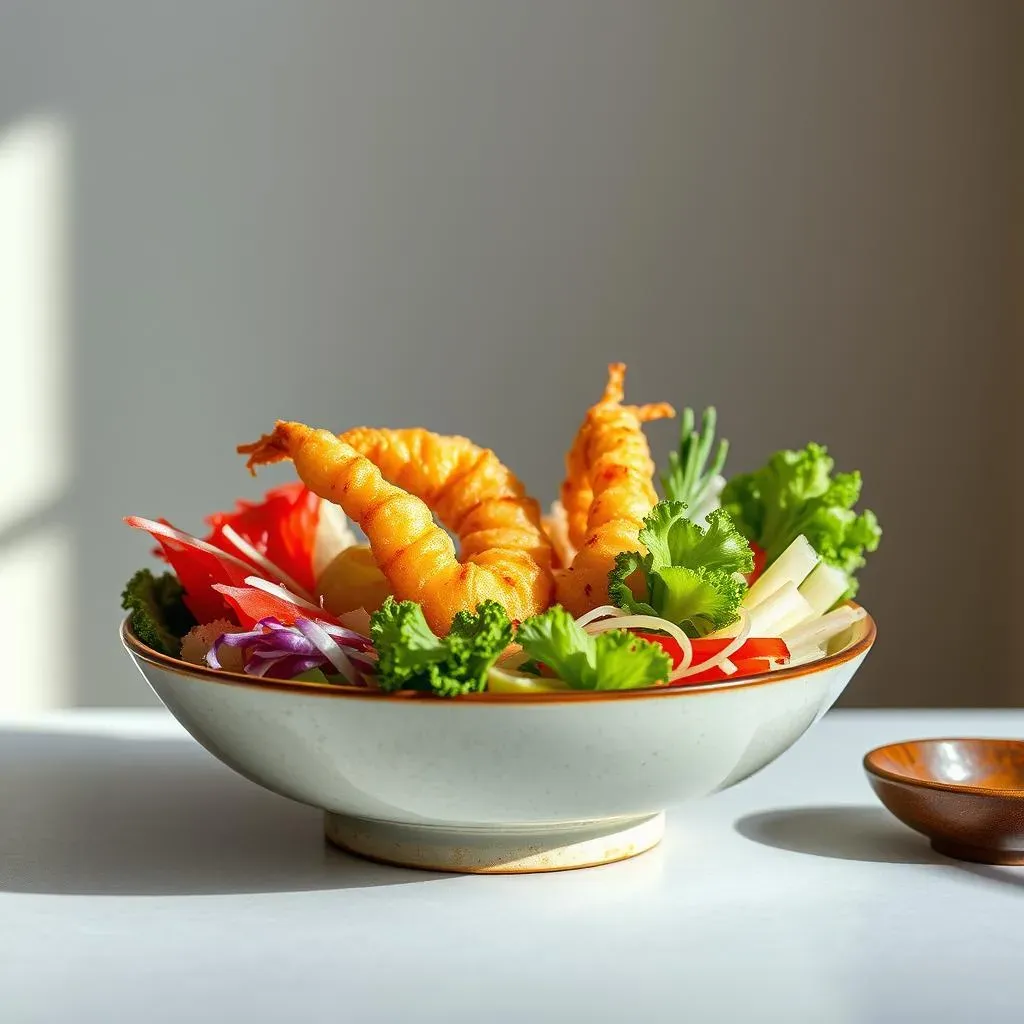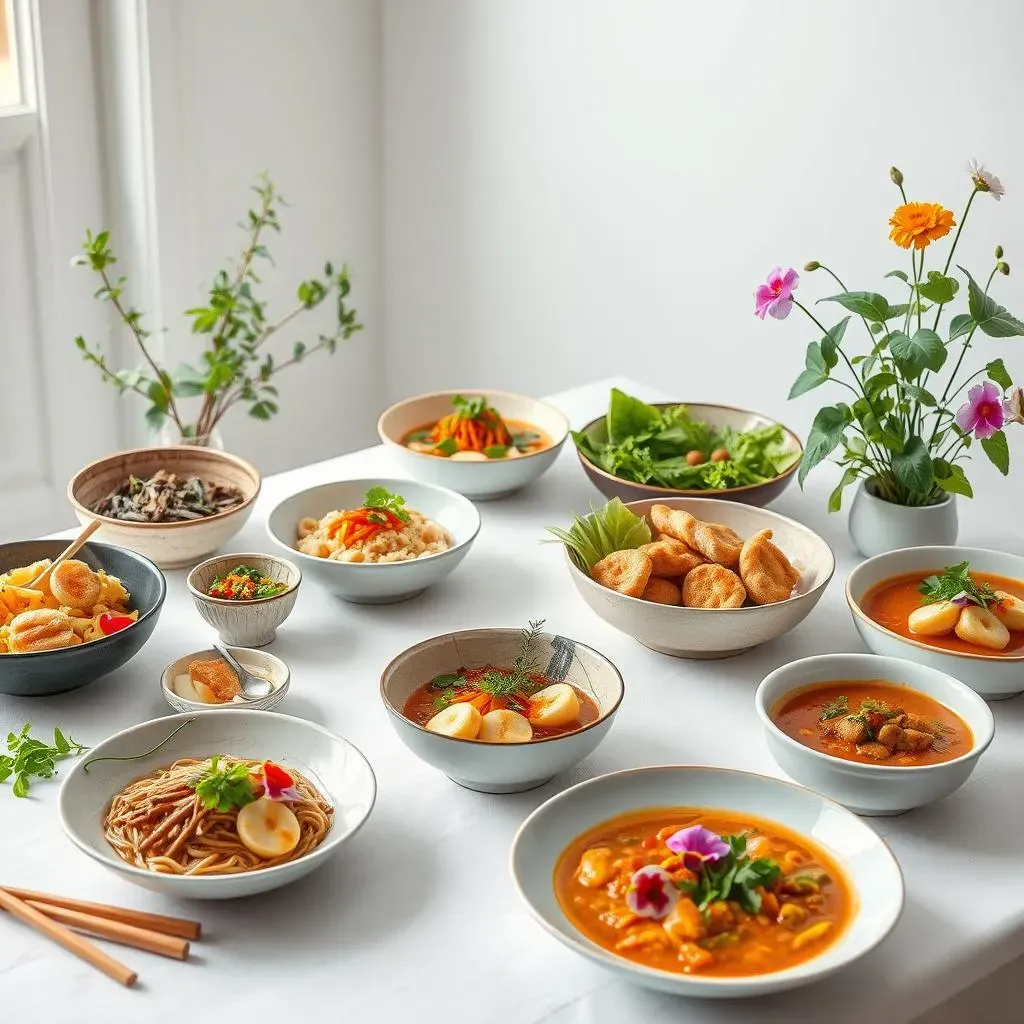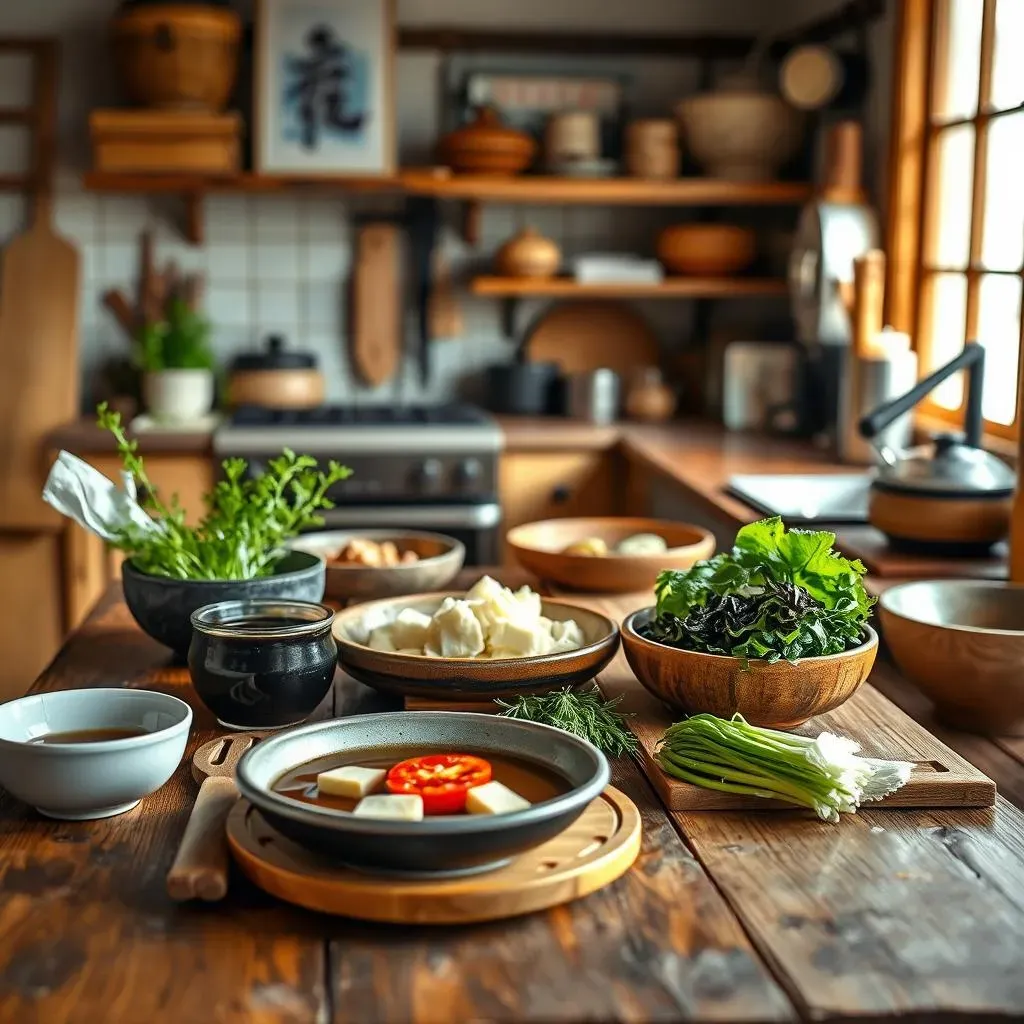Table of Contents
Are you ready to explore the amazing world of Japanese vegetarian meals? You might think Japanese food is all about fish, but guess what? There's a whole universe of delicious, plant-based dishes waiting for you. From rich, umami-packed ramen broths to flavorful tofu dishes, we're about to take a culinary trip that will change how you see Japanese cuisine. Forget boring salads, we are talking about vibrant, satisfying, and totally crave-able meals. This isn't just a list of recipes; it's a guide to unlocking the secrets of Japanese vegetarian cooking, with 15 of the most popular dishes that have been tested and loved by home cooks. Get ready to discover how easy it is to create authentic, mouthwatering Japanese vegetarian meals right in your own kitchen. We'll cover everything from the basic ingredients to the cooking techniques, making sure you have all the tools you need to become a Japanese vegetarian food master. So, grab your chopsticks, and let's get cooking!
Exploring the World of Japanese Vegetarian Cuisine
Exploring the World of Japanese Vegetarian Cuisine
A Surprising Discovery
When you think of Japanese food, what comes to mind? Probably sushi, right? Or maybe a big bowl of ramen with pork. Well, get ready to have your mind blown because there's a whole other side to Japanese cuisine that's bursting with plant-based goodness. I remember when I first started looking into it, I was shocked at how many dishes were naturally vegetarian or easily adaptable. It's not just about tofu; it's a beautiful tapestry of flavors and textures, all without any meat.
It's like discovering a secret garden that's been there all along. I was so used to thinking of Japanese food as fish-heavy, but the truth is, the Japanese have been masters of vegetarian cooking for centuries, influenced by Buddhist traditions and a deep respect for nature's bounty. It's not just an alternative; it's a whole culinary world waiting to be explored.
Beyond the Stereotypes
Let's ditch the idea that vegetarian food is boring or lacking in flavor. Japanese vegetarian cuisine is anything but. Think about the rich umami from mushrooms, the satisfying chewiness of mochi, the subtle sweetness of root vegetables, and the salty tang of seaweed. These are not just ingredients; they are the building blocks of incredibly complex and satisfying meals. It's all about layering flavors and textures to create dishes that are both comforting and exciting. You'll find that the Japanese approach to vegetarian food is not about imitation; it's about celebrating the natural flavors of plants, showcasing each ingredient in its best light.
It's about using ingredients that are not only good for you but also contribute to a symphony of tastes and aromas. I've been experimenting with these recipes for a while now, and each time, I'm amazed at how much depth and complexity you can achieve with just plants. The best part? It's all surprisingly accessible, even if you're new to Japanese cooking.
Ingredient | Flavor Profile | Common Use |
|---|---|---|
Shiitake Mushrooms | Earthy, Umami | Broths, Stir-fries |
Tofu | Mild, Versatile | Stir-fries, Soups, Grilled |
Seaweed | Salty, Briny | Soups, Salads, Wraps |
Miso | Salty, Savory | Soups, Marinades |
A Culinary Adventure
Exploring Japanese vegetarian cuisine is like embarking on a culinary adventure. It’s a chance to learn about new ingredients, techniques, and flavor combinations. It's not just about recreating dishes you've seen in restaurants; it's about understanding the philosophy behind the food. It's about taking your time to appreciate each step of the cooking process, from selecting the best ingredients to thoughtfully presenting the finished dish. You'll find that the more you explore, the more you'll fall in love with this unique and delicious culinary tradition. It’s a journey that is as much about the process as it is about the final meal.
I think that’s what makes it so rewarding. It's not just about eating; it's about experiencing a culture, learning new skills, and expanding your palate. So, are you ready to join me on this exciting culinary journey? I promise, you won't be disappointed.
MustTry Japanese Vegetarian Meals: A Culinary Journey
MustTry Japanese Vegetarian Meals: A Culinary Journey
A Feast for the Senses
Alright, so you're ready to dive into the good stuff? Let's talk about some must-try Japanese vegetarian meals that are not only delicious but also a joy to make. We're moving past the basic veggie sushi (though, let's be honest, that's still pretty great) and into some really exciting territory. I'm talking about dishes that will make your taste buds sing and have you saying "itadakimasu" (that's Japanese for "I humbly receive") with genuine enthusiasm. These aren't just meals; they're experiences, each with its own unique story and flavor profile. Think of it as a culinary passport, taking you on a tour of Japan one delicious bite at a time.
I remember the first time I tried a proper agedashi tofu, that perfectly crisp exterior giving way to a warm, silken interior, all swimming in a savory dashi broth. It was a revelation. And don't even get me started on the rich, complex flavors of a good vegan ramen, or the hearty satisfaction of a perfectly balanced vegetable curry. These dishes are proof that plant-based eating can be just as exciting and fulfilling as any meat-centric meal. So, let's embark on this culinary journey together, shall we?
Spotlight on Standout Dishes
let's get into some specifics. First up, we absolutely have to talk about Vegetarian Ramen. This isn't your college dorm ramen; this is the real deal, a symphony of flavors in a bowl. Think creamy, rich broth, perfectly cooked noodles, and a variety of toppings like marinated mushrooms, bamboo shoots, and soft boiled egg (optional, of course, if you're going full vegan). Then there's Agedashi Tofu, where silky tofu is coated in a light batter, deep-fried to perfection, and then served in a savory dashi broth with grated daikon and ginger. It's a textural masterpiece, and it's just so satisfying. And let's not forget Vegetable Tempura, light and crispy vegetables dipped in a delicate batter and fried to a golden perfection. Each bite is a burst of flavor and crunch.
These are just a few of the many dishes that make Japanese vegetarian cuisine so special. What I love about these dishes is that they're not only incredibly delicious but also surprisingly easy to make at home once you get the hang of it. It's all about understanding the basic techniques and using high-quality ingredients. And trust me, the effort is totally worth it when you take that first bite. I can almost taste it now!
- Vegetarian Ramen: Rich broth, noodles, and flavorful toppings.
- Agedashi Tofu: Crispy tofu in a savory broth.
- Vegetable Tempura: Lightly battered and fried vegetables.
- Vegetable Curry: Hearty and flavorful with a variety of veggies.
A World of Flavors
But wait, there's more! We're just scratching the surface here. Beyond those highlights, there's a whole spectrum of Japanese vegetarian meals to discover. Think about Miso Soup, a simple yet profound dish that's a staple in Japanese cuisine, and it's easily made vegetarian. It’s warm, comforting, and packed with umami. Then we have Ohitashi, blanched greens dressed with a light soy sauce-based dressing – simple, healthy, and delicious. And if you're looking for something a bit more substantial, try Vegetable Gyoza, pan-fried dumplings filled with a savory mix of vegetables. Each dish offers a unique glimpse into the versatility and depth of Japanese vegetarian cooking.
The beauty of these meals is that they're not only satisfying but also incredibly versatile. They can be adapted to your own tastes and preferences, and you can use whatever vegetables are in season. It's all about being creative and having fun in the kitchen. So, are you ready to try some of these amazing dishes? I know I am! I'm actually getting hungry just thinking about them.
Easy Japanese Vegetarian Recipes for Home Cooking
Easy Japanese Vegetarian Recipes for Home Cooking
Simple Steps, Big Flavors
so you're probably thinking, "This all sounds great, but is it actually doable for a weeknight meal?" I get it. Life's busy, and the idea of spending hours in the kitchen can be daunting. But here's the secret: Japanese vegetarian cooking can be surprisingly simple and quick. It's all about using fresh, high-quality ingredients and letting their natural flavors shine. We're not talking about complicated techniques or hard-to-find spices. We're focusing on recipes that are not only delicious but also easy to whip up, even if you're a beginner in the kitchen. I've been there, trying to make fancy meals that end up being a disaster, so trust me, these recipes are designed for real life.
The key is to break things down into easy-to-follow steps and to have a few essential ingredients on hand. Think of it as assembling a culinary puzzle, where each piece fits together to create a satisfying and flavorful meal. And the best part? You don't need any fancy equipment. A good knife, a pot, a pan, and you're pretty much set. I'm all about making cooking enjoyable and accessible, and these recipes are perfect for that. So, let’s get started!
Quick and Easy Recipes
Let’s dive into some specific recipes that are both easy and delicious. First up, we have Miso Soup. This is a staple in Japanese cuisine, and it's incredibly simple to make. You just need some miso paste, dashi (you can use vegetarian dashi), and your choice of tofu, seaweed, and vegetables. It's a great way to start a meal or even enjoy as a light lunch. Then, we have Ohitashi, which is basically blanched spinach or other leafy greens dressed with a simple soy sauce-based sauce. It's quick, healthy, and packed with flavor. And for something a bit more substantial, try Tofu and Vegetable Stir-Fry. Just chop up your favorite vegetables, stir-fry them with some tofu, and add a simple soy sauce-based sauce. It's a great way to use up whatever vegetables you have on hand, and you can easily customize it to your liking.
These recipes are proof that you don't need to spend hours in the kitchen to enjoy authentic Japanese flavors. They're perfect for busy weeknights when you want something healthy and delicious without the fuss. I've made these countless times, and they always hit the spot. Plus, they're a great way to introduce yourself to Japanese cooking without feeling overwhelmed. So, what are you waiting for? Let's get cooking!
Recipe | Prep Time | Cook Time | Difficulty |
|---|---|---|---|
Miso Soup | 5 minutes | 10 minutes | Easy |
Ohitashi | 5 minutes | 5 minutes | Easy |
Tofu Stir-Fry | 10 minutes | 15 minutes | Easy |
Tips for Home Cooks
Now, let's talk about some tips to make these recipes even easier and more enjoyable. First, make sure you have a few essential Japanese ingredients in your pantry. Things like soy sauce, miso paste, rice vinegar, and sesame oil are the building blocks of many Japanese dishes. Having these on hand will make it easier to whip up a meal any time you want. Second, don’t be afraid to experiment with different vegetables. Japanese cuisine is all about using seasonal ingredients, so feel free to use whatever is fresh and available. And finally, don’t stress about perfection. The beauty of home cooking is that it’s all about learning and having fun. Even if your dish doesn’t look exactly like the picture in a cookbook, it will still taste delicious.
Remember, cooking is a journey, not a destination. It's about exploring new flavors, trying new things, and enjoying the process. And with these easy recipes, you'll find that Japanese vegetarian cooking is not only doable but also incredibly rewarding. I know I've had so much fun exploring this cuisine, and I can't wait for you to experience the same. So, let’s get in the kitchen and start creating some magic!
Tips and Tricks for Making Authentic Japanese Vegetarian Meals
Tips and Tricks for Making Authentic Japanese Vegetarian Meals
Mastering the Basics
so you're getting the hang of the recipes, but now let's talk about taking your Japanese vegetarian meals from good to amazing. It's all about understanding the nuances of Japanese cooking and incorporating them into your own kitchen. We're going to discuss some key tips and tricks that will elevate your dishes and make them taste like they came straight from a traditional Japanese kitchen. I think the real secret is in the details, those small touches that make a big difference in flavor and presentation. It’s not just about following a recipe; it's about understanding the principles behind it and making them your own. So, let's get into the nitty-gritty and see how we can take your Japanese vegetarian cooking to the next level.
First, let's talk about dashi. This is the base of many Japanese dishes, and while traditional dashi uses fish flakes, you can easily make a vegetarian version using kombu (kelp) and shiitake mushrooms. It adds a deep umami flavor that’s essential for many recipes. Also, don't underestimate the importance of quality ingredients. Using fresh, seasonal vegetables will make a huge difference in the final flavor of your dish. And finally, remember that presentation is key in Japanese cuisine. Even a simple dish can look incredibly elegant with a little attention to detail. So, let’s get started!
Tip | Description |
|---|---|
Use Vegetarian Dashi | Make dashi with kombu and shiitake mushrooms for a deep umami flavor. |
Fresh Ingredients | Use fresh, seasonal vegetables for the best taste and texture. |
Presentation Matters | Pay attention to how you arrange the food on the plate. |
Flavor Secrets
Now, let's dive into some specific flavor secrets that will make your Japanese vegetarian meals sing. First, don't be afraid to experiment with different types of miso. There's a whole world of miso out there, from mild white miso to rich red miso, and each one has its own unique flavor profile. Using the right type of miso can make a huge difference in the taste of your dish. Also, consider the balance of flavors. Japanese cuisine is all about achieving a perfect harmony of sweet, salty, sour, bitter, and umami. Think about how each ingredient contributes to this overall balance, and adjust your seasonings accordingly. And finally, don't forget the importance of texture. A variety of textures can make a dish much more interesting and satisfying. Add some crunch with toasted sesame seeds, some chewiness with mochi, and some creaminess with tofu.
These little touches can make all the difference. It’s like adding a pinch of magic to your cooking. I've found that the more I experiment with these flavor secrets, the more my dishes come alive. It's like unlocking a hidden code, and once you understand it, the possibilities are endless. So, get creative, have fun, and don't be afraid to try new things. You might just discover your new favorite flavor combination. Remember, cooking is a journey, not a destination, and every step along the way is an opportunity to learn and grow.
- Experiment with different types of miso.
- Balance sweet, salty, sour, bitter, and umami flavors.
- Incorporate a variety of textures.
- Use fresh herbs like shiso and mitsuba for added flavor.
Presentation and Serving
Finally, let's talk about presentation and serving. In Japanese cuisine, the way a dish looks is just as important as how it tastes. So, take a moment to think about how you're plating your food. Use beautiful bowls and plates, and arrange the food in an appealing way. Think about the colors, textures, and shapes, and try to create a visually stunning masterpiece. Also, consider the serving size. Japanese meals are often served in small portions, with a variety of dishes, rather than one large plate. This encourages you to savor each bite and appreciate the flavors. And finally, don't forget the importance of good company. Food is meant to be shared, so invite some friends or family over and enjoy your delicious Japanese vegetarian meal together.
I think it's amazing how much difference a little attention to detail can make. It’s not just about making food that tastes good; it’s about creating an experience that engages all the senses. And when you put your heart into it, it really shows. So, take your time, have fun, and enjoy the process of creating beautiful and delicious Japanese vegetarian meals. I know I always do! And remember, the most important ingredient in any meal is love, so cook with passion and share with joy. It’s what makes all the difference.
Wrapping Up Our Japanese Vegetarian Adventure
So, there you have it, a tasty tour of 15 fantastic Japanese vegetarian meals. From the comforting warmth of ramen to the surprising flavors of agedashi tofu, we've shown that Japanese cuisine is so much more than just seafood. These recipes are your starting point, a launchpad to explore and experiment with plant-based Japanese cooking. Don't be afraid to tweak things, add your own favorite veggies, and make these dishes your own. The goal is to enjoy the process and, of course, to eat some seriously good food. Remember, the world of Japanese vegetarian meals is vast and full of delightful surprises, so keep exploring, keep cooking, and keep eating! Happy cooking!